Tomb Raider – Review
by Edward

|
 There exists a mantra born from a quote by a man named Eckhart Tolle that reads “Evolve or Die”. Though it was originally used to demonstrate that without reinvention mankind is doomed to repeat the same mistakes ad-infinitum, nowhere does this mantra seem more true than in the world of videogames. After a fourteen year delay that saw a company go under in the name of trying to keep up with the ever-moving goalposts instead of trying to surpass them, a tired, haggard Duke Nukem – once a cultural icon in the echelons of gaming- again asked us to Hail to the King, and instead saw lacklustre sales and poor critical reception as players instead hailed to the almighty dollar. Conversely, Lara Croft – one of the most recognisable characters in the industry – has been evolving, and the results make for one of the greatest swan-songs of this generation.
There exists a mantra born from a quote by a man named Eckhart Tolle that reads “Evolve or Die”. Though it was originally used to demonstrate that without reinvention mankind is doomed to repeat the same mistakes ad-infinitum, nowhere does this mantra seem more true than in the world of videogames. After a fourteen year delay that saw a company go under in the name of trying to keep up with the ever-moving goalposts instead of trying to surpass them, a tired, haggard Duke Nukem – once a cultural icon in the echelons of gaming- again asked us to Hail to the King, and instead saw lacklustre sales and poor critical reception as players instead hailed to the almighty dollar. Conversely, Lara Croft – one of the most recognisable characters in the industry – has been evolving, and the results make for one of the greatest swan-songs of this generation.
Taking place in a separate continuity from the original Core Design titles and Crystal Dynamics’ earlier efforts, the latest Tomb Raider aims to tackle the rebirth of Lara Croft from a dinosaur-extincting thief to a survivor. The story begins when Lara – now a 21-year old graduate working alongside a famous archaeologist on the search for the mystical island of Yamatai – persuades the crew of The Endurance to enter the dreaded Dragon’s Triangle. Her decision causes the ship to find the island they’ve been looking for, but the crew becomes shipwrecked and it falls to Lara to help reunite her friends, uncover the mysteries surrounding Yamatai and find a way home before they’re all killed.
Impeding her progress are the Solarii, a cult formed by a man calling himself ‘Father Mathias’, who was himself shipwrecked twenty years ago and believes that the key to getting off of the island involves the Sun Queen Himiko, who once ruled over Yamatai. Though the Solarii are formed from people who’ve found themselves shipwrecked since Mathias’ arrival, over time they’ve become violent and brutal, and will stop at nothing to prevent Lara from getting her best friend Sam back from their clutches.
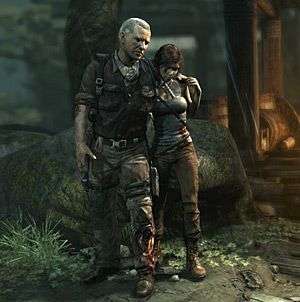 From the opening sequence, players will have the controller firmly clutched in their hands, as even the brief tutorial is full of suspense and imminent danger for Miss Croft, as she manages to burn herself, get impaled, attacked and nearly crushed during a cave-in within the first few minutes alone. After those frantic minutes wrestling through QTEs and the brief respite that an early puzzle affords, you’re charged with finding a camp, a weapon to defend yourself with and food to survive. Though this early section of gameplay was well-documented during E3 and Gamescom, I was glad to see that even then plenty had been played close to the chest as, while Lara camped out and took refuge from the storm, I was treated to some flashbacks courtesy of the camera she had found. During the trip to the island, Sam was recording footage, and these snippets pop up during the first half of the story to help flesh out and give the supporting cast a chance to shine before hoisting the focus back on our protagonist as she attempts to save the day.
From the opening sequence, players will have the controller firmly clutched in their hands, as even the brief tutorial is full of suspense and imminent danger for Miss Croft, as she manages to burn herself, get impaled, attacked and nearly crushed during a cave-in within the first few minutes alone. After those frantic minutes wrestling through QTEs and the brief respite that an early puzzle affords, you’re charged with finding a camp, a weapon to defend yourself with and food to survive. Though this early section of gameplay was well-documented during E3 and Gamescom, I was glad to see that even then plenty had been played close to the chest as, while Lara camped out and took refuge from the storm, I was treated to some flashbacks courtesy of the camera she had found. During the trip to the island, Sam was recording footage, and these snippets pop up during the first half of the story to help flesh out and give the supporting cast a chance to shine before hoisting the focus back on our protagonist as she attempts to save the day.
Even early on, Tomb Raider gives you plenty to appreciate, as even during the tutorial hand-holding is minimal at best. When new items present themselves, you’re given a brief description of how to use them and then you’re left to your own devices to figure out what to do, and it allows progress to feel far more organic than other titles of its calibre. Too often are the opening moments a slog if you’re accustomed to the genre, but here Lara’s exploits are genuinely fun to play, and suspense is rife as the ever-present threats of Yamatai are keen to rear their ugly heads.
Another pleasant surprise is the complete lack of a HUD during regular gameplay, allowing you to soak up the visual splendour at hand; every main hub area feels wholly unique and distinctive, and traversal is an absolute joy as a result. Every environment is beautiful in its own way, and you can barely swing the camera around without finding something you’d want to take a screenshot of. So arresting are the sights at hand that I didn’t even notice that the normally ever-present information boxes were nowhere to be found, and when I did notice I was only happier for their absence. That’s not to say you’re completely on your own, as the standard ammo count and aiming reticule will show up when you’re brandishing weapons, and if you’re stuck or unsure of your surroundings you can always employ Lara’s survival instinct.
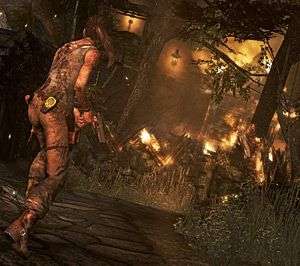 Available at the touch of a shoulder button, survival instinct throws the world around you into monochrome and highlights the most pertinent information with a yellow or red hue; red representing enemies whose deaths will alert others around them, and yellow representing enemies who can be killed stealthily, journals, explosive barrels, GPS caches, animals, maps, relics, and any other interactive items in the immediate area. Throughout the course of your adventure, survival instinct will soon become a vital addition to your arsenal, especially if you’re planning on hunting down all of the optional collectables scattered around the island. Taking the form of the aforementioned GPS caches, maps, journals and relics, the latter two help flesh out the back-story of the island and its inhabitants more clearly, while procuring all of them will grant Lara some all-too vital experience points.
Available at the touch of a shoulder button, survival instinct throws the world around you into monochrome and highlights the most pertinent information with a yellow or red hue; red representing enemies whose deaths will alert others around them, and yellow representing enemies who can be killed stealthily, journals, explosive barrels, GPS caches, animals, maps, relics, and any other interactive items in the immediate area. Throughout the course of your adventure, survival instinct will soon become a vital addition to your arsenal, especially if you’re planning on hunting down all of the optional collectables scattered around the island. Taking the form of the aforementioned GPS caches, maps, journals and relics, the latter two help flesh out the back-story of the island and its inhabitants more clearly, while procuring all of them will grant Lara some all-too vital experience points.
One of the many feathers in Tomb Raider’s cap includes RPG elements, and mastering both levelling systems is a must to help facilitate Lara’s survival. The first of these is based off of experience, which Lara is given for exploring, uncovering collectables, killing animals, other people and raiding tombs. The skills that can be learnt from experience are then split into three subsets – Survival, Hunter and Brawler; the former focuses more on traversing the environment and scavenging, the second the use of weapons against foes, and the latter on close-quarters combat. Each of these subsets is then split off into a further three tiers, the first tier being unlocked right away and the final two being closed off to players until they further level up, though unlike in previous demo builds, higher-tier abilities don’t require more than one skill point to acquire once they’ve available, though some may be locked off until an associated ability is mastered.
The second system doesn’t affect Lara’s skill-set directly, but, rather, her weaponry, as the player collect salvage in order to modify her arsenal for maximum deadliness. This quest can be made easier dependant on what skills are mastered, but exploration is also encouraged in order to collect the necessary amount of scrap needed to fully upgrade every weapon. Each weapon starts out with the standard upgrades to damage and fire rate, but as more of Yamatai is uncovered, players will be rewarded with new iterations of previous weapons, upgrades to those previously existing, and parts that, when collected from salvage crates, combine to allow that weapon to be levelled up.
 Both of these systems can often result in making some tough decisions as to how to proceed, though these will occur at opposing points throughout the story; during the first half the experience-based levelling will be wrought with tough decisions as you’re forced to prioritise what’s more important to survive, while the second half will see more scrutiny poured over what weapon needs the upgrade most pressingly, and whether it’s best to go for the easier upgrade or save up for the more devastating modifications.
Both of these systems can often result in making some tough decisions as to how to proceed, though these will occur at opposing points throughout the story; during the first half the experience-based levelling will be wrought with tough decisions as you’re forced to prioritise what’s more important to survive, while the second half will see more scrutiny poured over what weapon needs the upgrade most pressingly, and whether it’s best to go for the easier upgrade or save up for the more devastating modifications.
Maxing out either involves a strong amount of dedication, though it must be said it’s easier to complete the experience system; if you endeavour to snap up all of the collectables and finish the optional tombs, then you’ll reach the final level with an hour or so left to play with before you reach the point of no return. Conversely, for every weapon to reach its full potential requires some farming, as players can approach the end-game having done everything there is to offer and still find they’re lacking enough salvage for the last couple of mods.
Any potential frustration at the hands of hunting everything down is totally eliminated by just how perfectly the world comes together; every main hub area is expertly designed and provides plenty of avenues for exploration and experimentation, and many have one or two additional challenges that provide some extra experience points, though admittedly a lot of these involve setting fire to x amount of objects, and none of these are highlighted on your map before or after you’ve found them. That’s hardly a complaint though – these challenges provide more incentive to come back and give more scrutiny to places you’ve already been, and this is encouraged moreso once you’ve upgraded your arsenal to access previously locked-off areas. This isn’t done cynically by depriving you of vital items until you’ve acquired a certain object, but by hiding just one or two collectables away, rewarding the completionists and not disadvantaging those who aren’t.
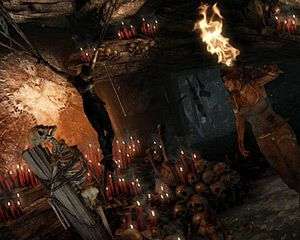 This design ethic permeates the entirety of Tomb Raider, and I never found myself frustrated or annoyed, instead, finding myself constantly in awe of the way the world came together because at times it feels like the developers thought of everything that could happen and worked it all in. This is most prevalent during the optional tombs – short sections of gameplay that harken back to the Tomb Raider of yore by testing your brain more than your ability to shoot. Thankfully, you won’t be expected to pick up a crank part and backtrack for miles to activate a bridge, but instead you’ll be faced with a single area (and an often physics-based) puzzle standing between you and the treasure inside the tomb. While they’re not the most taxing brainteasers around, they’re a delightful addition for those wanting something a bit more cerebral.
This design ethic permeates the entirety of Tomb Raider, and I never found myself frustrated or annoyed, instead, finding myself constantly in awe of the way the world came together because at times it feels like the developers thought of everything that could happen and worked it all in. This is most prevalent during the optional tombs – short sections of gameplay that harken back to the Tomb Raider of yore by testing your brain more than your ability to shoot. Thankfully, you won’t be expected to pick up a crank part and backtrack for miles to activate a bridge, but instead you’ll be faced with a single area (and an often physics-based) puzzle standing between you and the treasure inside the tomb. While they’re not the most taxing brainteasers around, they’re a delightful addition for those wanting something a bit more cerebral.
That’s not to say the rest of the single-player isn’t intelligently designed – I’d go as far as to say the third-person shooting mechanics are my flat-out favourite of any third-person shooter I’ve played in years. It never feels like Lara’s catching up to the long-deigned masters of cover-based shooting, but instead that she’s taken what made them strong, evolved and surpassed them all. For one, there’s no snapping to cover as Lara will automatically duck behind it; there’s no button press to make her move in and out of cover, making movement during gunfights feel more dynamic. Second, you’re encouraged to keep moving about the battlefield, rather than camp behind the same piece of cover – Solarii will occasionally throw dynamite or Molotov cocktails aimed at dislodging the player from cover or to move them away from it entirely. Third, conflict isn’t constant – there are plenty of scraps to get into, but you’re not just moving from one fight to another; the battles are spread out and Lara will often be granted with new weaponry or enough salvage to upgrade her arsenal at well-paced junctures, meaning that fighting never feels stale.
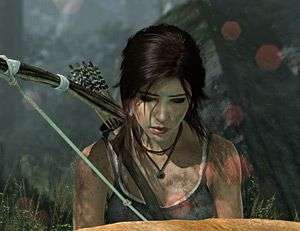 Finally, you’re never faced with near-insurmountable hordes of enemies in the name of ramping up the challenge, despite the fact that nearly every single third-person shooter mistakenly thinks that’s how it’s done. Instead, Crystal Dynamics have made sure that the challenge always comes from the environment you’re fighting in, rather than the amount of enemies you’re facing. Even on hard mode the level of enemies never feels like one too many, and the difficulty from every confrontation comes from whether you master the battlefield or let it master you. Before playing, I was worried that the third-person combat sections would end up being the most frustrating and weakest parts of the single-player, but instead I found myself not dreading a gunfight for the first time in years.
Finally, you’re never faced with near-insurmountable hordes of enemies in the name of ramping up the challenge, despite the fact that nearly every single third-person shooter mistakenly thinks that’s how it’s done. Instead, Crystal Dynamics have made sure that the challenge always comes from the environment you’re fighting in, rather than the amount of enemies you’re facing. Even on hard mode the level of enemies never feels like one too many, and the difficulty from every confrontation comes from whether you master the battlefield or let it master you. Before playing, I was worried that the third-person combat sections would end up being the most frustrating and weakest parts of the single-player, but instead I found myself not dreading a gunfight for the first time in years.
The only real problem I have with the battles is that even though they never outstay their welcome, they create a slowly widening dissonance between the gameplay and the story. The hard line that Crystal Dynamics took during the controversy that marred discussions of Tomb Raider last year was that a particular scene in the first hour was meant to highlight the emotional trauma of Lara committing her first kill. While that scene is in itself problematic owing to the fact that the inappropriate contact juxtaposes too heavily with the potential outcomes – all of which involve Lara being strangled or shot – there’s no lasting impact to the scene. Within five minutes of Lara’s first kill she goes on to commit more murders than the Manson Family, and when Roth – a member of The Endurance and Lara’s mentor and father figure – asks “you had to kill someone? That must have been hard for you”, Lara replies that “it’s scary just how easy it was”. Lara’s adventures in genocide are then completely unaddressed apart from an attempted soul-searching question by the villain du jour that’s not only identical to a line posed in a rival series, but instantly disregarded in much the same way, thus undermining its impact.
Lara’s first kill was designed to drive home the idea that Lara’s being pushed to do what she has to in order to survive, but this eventually becomes diametrically opposed to the actual gameplay that constantly provides bonus experience for stylish, skilful and gory kills in order to unlock and master abilities that help increase the opportunities for performing said kills and providing greater bonuses for doing so. When you consider that a cut-scene only minutes before was changed entirely from what had been witnessed in preview builds, and the justification given was to add suspense and improve the narrative, yet the most controversial and problematic scene wasn’t altered at all; it raises a whole litany of questions that may never be answered satisfactorily.
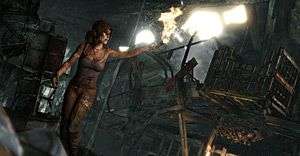 The lack of stealth options also runs counter to the narrative’s emphasis on Lara surviving; you’re often given the chance to kill people stealthily, but there’s often no way to avoid conflict entirely, and even if it was possible it would be the least optimal path to take because you’re rewarded for engaging in conflict, not avoiding it. The lack of alternatives is telling, especially as the stealth option is often a rare opportunity and, for the most part, will only allow you to get the drop on one or two enemies before entering a larger-scale battle.
The lack of stealth options also runs counter to the narrative’s emphasis on Lara surviving; you’re often given the chance to kill people stealthily, but there’s often no way to avoid conflict entirely, and even if it was possible it would be the least optimal path to take because you’re rewarded for engaging in conflict, not avoiding it. The lack of alternatives is telling, especially as the stealth option is often a rare opportunity and, for the most part, will only allow you to get the drop on one or two enemies before entering a larger-scale battle.
To say there’s no stealth is a misnomer – there are moments where its imperative for Lara to eliminate everyone without drawing attention as the odds are too heavily-stacked against her if she’s caught, but thankfully being spotted is never a guarantee of failure and these diversions are the exception rather than the rule. That this is the case is actually largely beneficial to Tomb Raider, as even though these events can be thrilling and are more cerebral than a straight-up conflict, it highlights how the variation and pacing is crafted so expertly that sections of gameplay differing from the norm serve as a way to spice up proceedings and don’t outstay their welcome. Quick-time events exist, but they’re far less prevalent than previews suggest and, for the most part, disappear after Croft’s first kill. When they are employed, they’re used to emphasise Lara’s desperation or make sure that you’re focused during some of the trickier climbs. There are moments where stealth reigns supreme, but these aren’t a case of “be seen and fail”. Several events force the action on-rails, but these don’t require a degree in precognition to pass successfully.
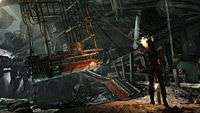 |
 |
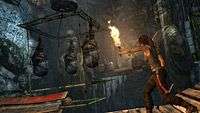 |
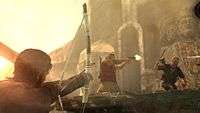 |
 |
 |
With that being said, the divergent paths between narrative and action consists of the only flaw I can legitimately level at Tomb Raider’s single-player, and it was only one I could level about two thirds of my way into a campaign that took me around twenty hours to complete. That alone should speak volumes. Granted, I have a minor issue with the fact that the volume for sound effects and speech were controlled by the same dial and the initially jarring presentation of the subtitles – superimposed over a black bar for no real discernible reason – but that’s being especially nit-picky and it never impacted my experience.
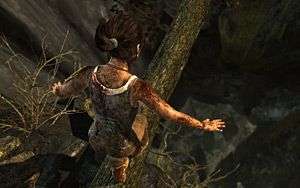 Admittedly, it’s unlikely that the narrative will stand up as the best this year has to offer due to the previously listed issues and the the severe lack of development for all of the supporting cast bar Roth, many of whom only get a few lines of dialogue ascribing them to an oft-seen personality type and a journal entry or two providing a minor amount of back-story Regardless, the single-player is one of the best I’ve had the pleasure of playing in years; I felt compelled to complete everything in the story mode, didn’t stop until I’d achieved 100% completion and still have to supress the urge to play over again.
Admittedly, it’s unlikely that the narrative will stand up as the best this year has to offer due to the previously listed issues and the the severe lack of development for all of the supporting cast bar Roth, many of whom only get a few lines of dialogue ascribing them to an oft-seen personality type and a journal entry or two providing a minor amount of back-story Regardless, the single-player is one of the best I’ve had the pleasure of playing in years; I felt compelled to complete everything in the story mode, didn’t stop until I’d achieved 100% completion and still have to supress the urge to play over again.
I wish that was all there was to the new Tomb Raider – a stunning return to form for one of gaming’s greatest icons, but unfortunately Square-Enix saw fit to package in a multiplayer mode. Though I’m not traditionally a multiplayer man by trade, I went into it with as open a mind as possible, and found myself ultimately disappointed. It’s not that it’s fundamentally flawed or outright terrible, it’s just nowhere near as much fun as the single-player.
Developed by Eidos Montreal, Tomb Raider’s multiplayer pits you as either the Survivors or the Solarii over five maps and four different modes. Two of these modes are as standard as they come – Team Death-match and a Free-For-All, with the latter’s gimmick being that the most dominant player needs to be put down first before they become the executioner, as if they remain in that role for too long then they can claim victory before hitting the normal win requirement. The other two are variants on industry standard; Cry for Help tasks the Survivors with trying to get radio masts up and running to broadcast for help while the Solarii try to stop them and steal their batteries (which doesn’t entirely make sense when you consider that the Solarii want off the island, too), while Rescue charges the Survivors with recovering medical supplies. The gimmick in Rescue is that the Survivors become downed after prolonged damage, and the Solarii have to run up and bash their skulls in with their climbing tools before they earn the points necessary to win.
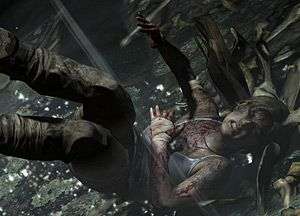 When it comes down to it, however, victory in any team-based battle simply comes down to who can camp the quickest. While enemies can’t enter your spawn point, the most common occurrence is that enemies will park nearby and wipe out anyone who dares leave, and players have to leave eventually thanks to a warning that they’ll be booted if they stay in the spawn area for much longer. Even if the spawn points aren’t ambushed, vital areas of the map will be thanks to obvious choke-points and small arenas of battle. Rescue in particular is frustrating to play thanks to this, as the drop point for supplies never changes, giving every incentive for the Solarii to pull up a chair and wait for the battle to come to them.
When it comes down to it, however, victory in any team-based battle simply comes down to who can camp the quickest. While enemies can’t enter your spawn point, the most common occurrence is that enemies will park nearby and wipe out anyone who dares leave, and players have to leave eventually thanks to a warning that they’ll be booted if they stay in the spawn area for much longer. Even if the spawn points aren’t ambushed, vital areas of the map will be thanks to obvious choke-points and small arenas of battle. Rescue in particular is frustrating to play thanks to this, as the drop point for supplies never changes, giving every incentive for the Solarii to pull up a chair and wait for the battle to come to them.
Playing online is also an occasionally glitchy affair, and while I didn’t come across a single issue when playing alone, within an afternoon of playing online I’d managed to come across several. It’s also annoying that there’s not much care put into placing players of a similar level against each other whether the matches are ranked or casual, and it’s not uncommon to see people in their first match pitched against a team of level twenty or thirty somethings. The only thing the multiplayer does that felt remotely fresh was the addition of traps that could be set up around the map, but even these feel like a waste as they are always in fixed locations, so it’s often the case that both you and your opponents will circumvent those areas entirely before long, meaning that this one gimmick goes to waste very quickly.
While the multiplayer is a let-down, it’s ultimately superfluous to the experience and it’ll swiftly be forgotten in due time. What won’t be forgotten is just how powerful the single-player is, as it revitalises one of our industry’s most iconic (if outdated) characters and gives her a title that deservingly thrusts her back into the limelight, and will hopefully keep her there for years to come. Even if you don’t disregard the multiplayer, Tomb Raider stands as a must-play and an almighty swansong to this generation.
Pros- Lengthy campaign which feels consistently varied and never outstays its welcome
- Possibly the best third-person shooting mechanics I've witnessed in years
- Beautiful art-style that gives birth to scenery porn at a camera-swing
- Lack of HUD and minimal tutorial that refuses to mollycoddle the player
- RPG elements that incite experimentation and tough decisions
- Strong voice-acting gives life to all of the characters, even the minor ones
- Perfectly-crafted environments that prevent frustration and encourage exploration
- Plenty of collectables, challenges and optional tombs that add hours to those desperate for more
- Will make you fall in love with Lara all over again
- Who puts the volume for sound-effects and voices on the same controllable dial? Seriously?
- Lara keeps talking to herself and I'm worried she might have a problem
- A story that emphasises that Lara is "doing what she can to survive" and a system that rewards you for gory murdering causes a jarring juxtaposition
- Multiplayer is an occasionally-glitchy and ultimately forgettable affair
So much could have gone wrong with a reboot of one of gaming's most valuable icons, but the fact that so little did is a testament to the incredible work Crystal Dynamics have achieved with Tomb Raider 2013. The single-player is one of the most refreshing, refined and incredible campaigns I've played in years, and I didn't find myself bored even once throughout the twenty or so hours that it took me to reach 100% completion. It's a near-perfect reinvention of Lara Croft, that's almost let down by a superfluous and unnecessary multiplayer mode. While it doesn't ruin the package entire, it does prevent me from giving the full marks this title would deserve if was single-player only. With or without the multiplayer, Tomb Raider is an unmissable adventure that will stand proud as one of the greatest titles of this generation, and a stellar return to form for one of the industry's finest.
Last five articles by Edward
- Best of 2015: Journey's End: A New Beginning
- Journey's End: A New Beginning
- You Can't Choose Your Happy Ending
- Okay, Let's Fix Comedy In Games - The V-Effekt
- Time Keeps On Smashing Away
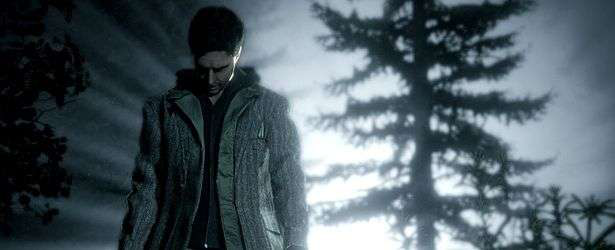



















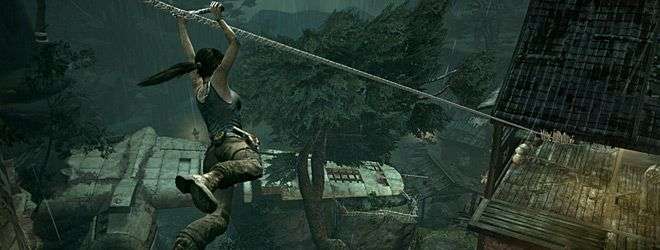
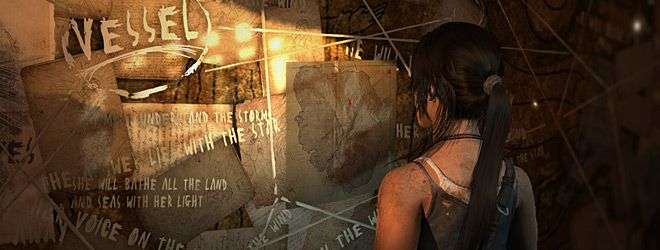
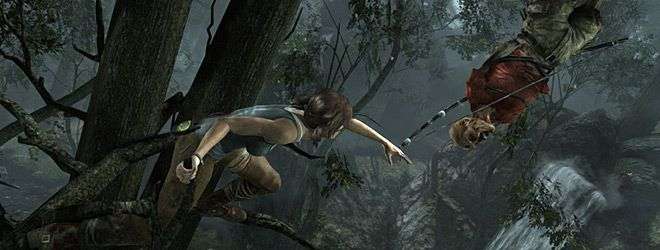
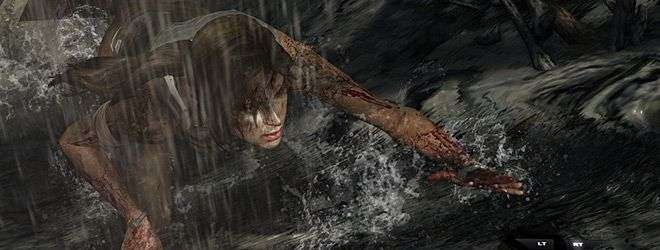






Agreed. This is probably the first truly great game I’ve played for nearly a year. The biggest mystery of all is where does Tomb Raider go next?